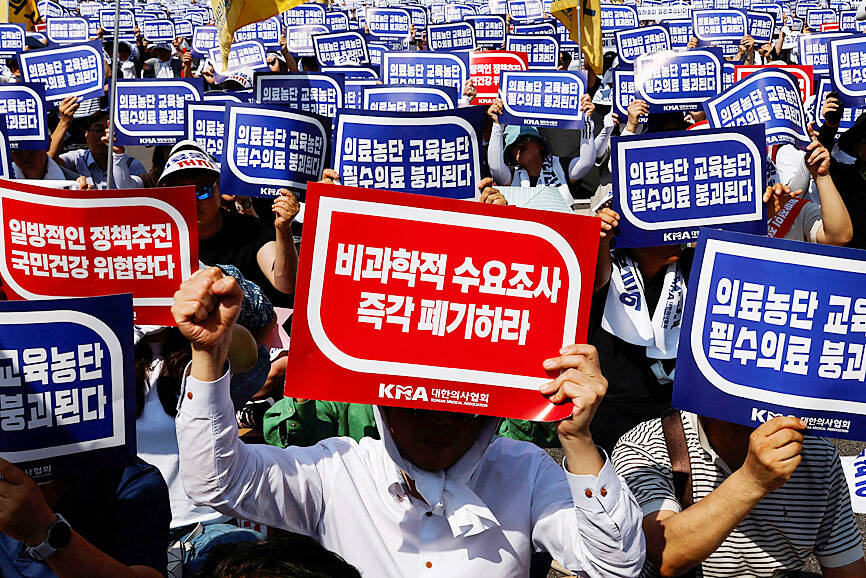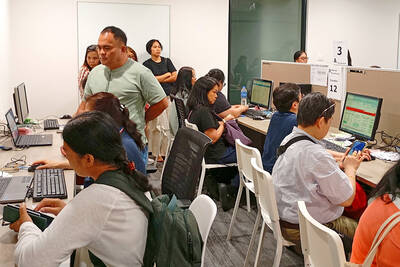The South Korean government yesterday announced that it would abandon its plan to suspend the licenses of striking junior doctors as part of its efforts to convince them to return to work and resolve the nation’s monthslong medical impasse.
It was not immediately known whether the thousands of striking doctors would return to their hospitals after the announcement.
The government’s concession could also invite accusations of unfairness given its treatment of previous labor strikes and of doctors who have already returned to work.

Photo: Reuters
South Korean Minister of Health and Welfare Cho Kyoo-hong said the government has decided not to suspend the licenses of the strikers, who are medical interns and residents, regardless of whether they return to their hospitals or not.
He said the government would also offer special measures to returnees to minimize the gap in their training and help them obtain specialist licenses in time.
“After painstaking deliberations, the government has reached this decision based on an assessment that minimizing the medical vacuum in the treatment of emergency and seriously ill patients and maintaining a training system to supply specialists at the right time will serve the public interest more than anything else,” Cho said.
More than 90 percent of the nation’s 13,000 medical interns and residents walked off their jobs in February to protest the government’s plan to sharply boost medical school admissions. The walkout has significantly burdened the operations of university hospitals where they were training and threatened to disrupt South Korea’s medical services.
Some senior doctors and professors at those teaching schools supported the walkout by holding rallies and temporarily walking off their jobs or reducing their working hours.
Officials have said they want to add up to 10,000 doctors by 2035 to cope with a fast-aging population and a shortage of physicians in rural areas and in low-paying yet essential specialties like pediatrics and emergency departments.
Doctors say schools are not ready to handle such an abrupt increase in students and that it would ultimately undermine the nation’s medical services.
However, critics say physicians, one of the best-paid jobs in South Korea, are mainly worried that having more doctors would lower their future incomes.
The striking doctors suffered a major legal setback after a Seoul court in May ruled in support of the government’s plan. The Supreme Court last month upheld that ruling.
The government later took steps to withdraw its plan to suspend the licenses of doctors who returned to their hospitals, but did not do so for those who remained off the job. Only a small number of strikers have returned to work.
As of Friday last week, about 8 percent of the 13,756 medical interns and residents at about 210 teaching hospitals were working, government records show.
Government officials earlier threatened to impose three-month license suspensions on striking doctors and even indictments by prosecutors for refusing back-to-work orders. South Korean President Yoon Suk-yeol — who has said illegal strikes should be dealt with in line with the law — also called the doctors’ walkout an “illegal collective action.”
The standoff created strife among doctors, with some harassing colleagues who opted not to join or continue the strike, local media reports said.
Cho said the government was aware of possible criticism over the issue of fairness in its decision not to suspend the licenses of the striking doctors.
He said patient groups and some medical officials have called for an early end of the walkout by the striking doctors.
Last month, the government finalized a plan to increase next year’s medical school enrollment by about 1,500, down from its earlier push for an increase of 2,000 students.
The current medical student enrollment cap has been unchanged at 3,058 since 2006, with doctors blocking previous government attempts to raise it with vehement protests.

Kehinde Sanni spends his days smoothing out dents and repainting scratched bumpers in a modest autobody shop in Lagos. He has never left Nigeria, yet he speaks glowingly of Burkina Faso military leader Ibrahim Traore. “Nigeria needs someone like Ibrahim Traore of Burkina Faso. He is doing well for his country,” Sanni said. His admiration is shaped by a steady stream of viral videos, memes and social media posts — many misleading or outright false — portraying Traore as a fearless reformer who defied Western powers and reclaimed his country’s dignity. The Burkinabe strongman swept into power following a coup in September 2022

‘FRAGMENTING’: British politics have for a long time been dominated by the Labor Party and the Tories, but polls suggest that Reform now poses a significant challenge Hard-right upstarts Reform UK snatched a parliamentary seat from British Prime Minister Keir Starmer’s Labor Party yesterday in local elections that dealt a blow to the UK’s two establishment parties. Reform, led by anti-immigrant firebrand Nigel Farage, won the by-election in Runcorn and Helsby in northwest England by just six votes, as it picked up gains in other localities, including one mayoralty. The group’s strong showing continues momentum it built up at last year’s general election and appears to confirm a trend that the UK is entering an era of multi-party politics. “For the movement, for the party it’s a very, very big

A new online voting system aimed at boosting turnout among the Philippines’ millions of overseas workers ahead of Monday’s mid-term elections has been marked by confusion and fears of disenfranchisement. Thousands of overseas Filipino workers have already cast their ballots in the race dominated by a bitter feud between President Ferdinand Marcos Jr and his impeached vice president, Sara Duterte. While official turnout figures are not yet publicly available, data from the Philippine Commission on Elections (COMELEC) showed that at least 134,000 of the 1.22 million registered overseas voters have signed up for the new online system, which opened on April 13. However,

ENTERTAINMENT: Rio officials have a history of organizing massive concerts on Copacabana Beach, with Madonna’s show drawing about 1.6 million fans last year Lady Gaga on Saturday night gave a free concert in front of 2 million fans who poured onto Copacabana Beach in Rio de Janeiro for the biggest show of her career. “Tonight, we’re making history... Thank you for making history with me,” Lady Gaga told a screaming crowd. The Mother Monster, as she is known, started the show at about 10:10pm local time with her 2011 song Bloody Mary. Cries of joy rose from the tightly packed fans who sang and danced shoulder-to-shoulder on the vast stretch of sand. Concert organizers said 2.1 million people attended the show. Lady Gaga